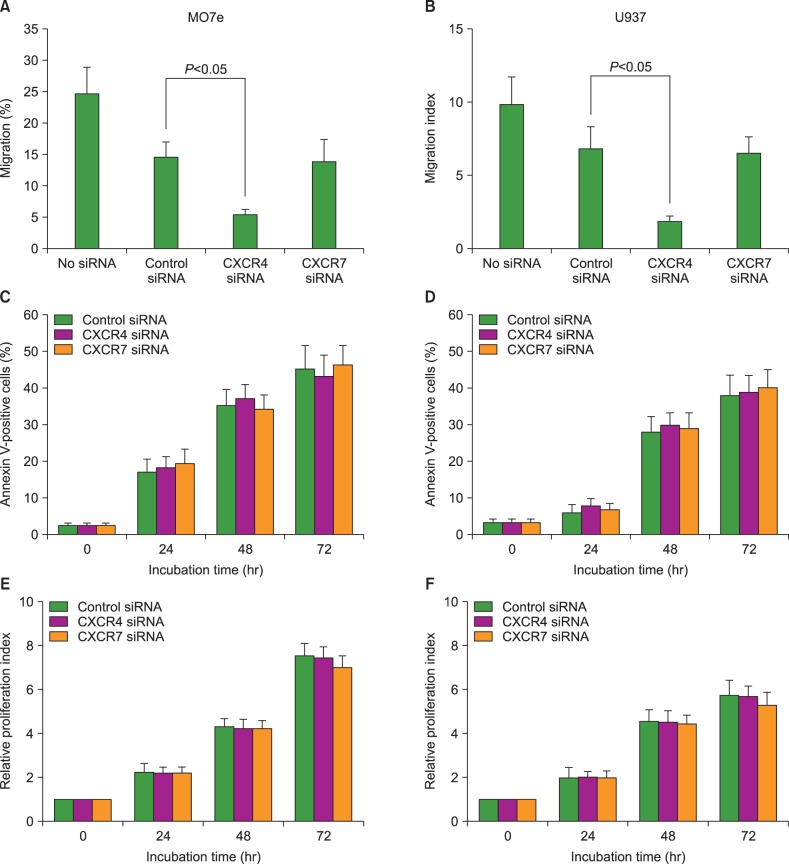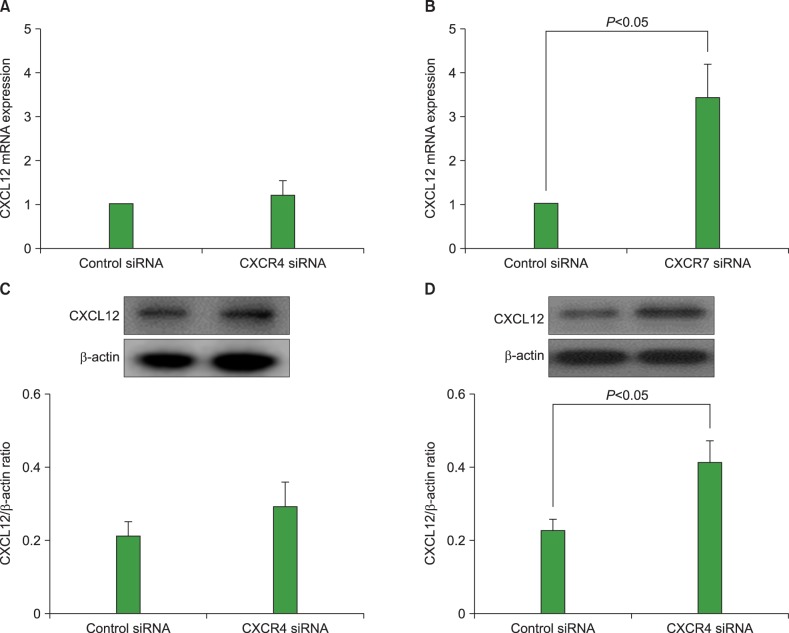Blood Res.
2015 Dec;50(4):218-226. 10.5045/br.2015.50.4.218.
Expression and functional roles of the chemokine receptor CXCR7 in acute myeloid leukemia cells
- Affiliations
-
- 1Department of Drug Activity, New Drug Development Center, Medical Innovation Foundation, Osong, Daejeon, Korea.
- 2Department of Internal Medicine, School of Medicine, Chungnam National University, Daejeon, Korea. deogyeon@cnu.ac.kr
- KMID: 2133756
- DOI: http://doi.org/10.5045/br.2015.50.4.218
Abstract
- BACKGROUND
The C-X-C chemokine receptor 7 (CXCR7) has been shown to be a decoy receptor for CXCR4 in certain cell types. We investigated the expression status and functional roles of CXCR7 in acute myeloid leukemia (AML) cells in vitro.
METHODS
CXCR7 mRNA was knocked down in AML cells by using small interfering RNA (siRNA) technology, and subsequent biological alterations in the cells were evaluated in vitro.
RESULTS
All AML cell lines examined in this study (U937, K562, KG1a, HL-60, and MO7e) and primary CD34+ cells obtained from patients with AML expressed CXCR7 mRNA at various levels. Western blotting showed that all AML cells produced CXCR7. Furthermore, all AML cells expressed CXCR7 in both the cytoplasm and on the cell surface at various levels. Stromal cell-derived factor-1 (SDF-1; C-X-C motif ligand 12 (CXCL12)) induced internalization of cell surface CXCR7. However, neither hypoxia nor the examined hematopoietic growth factors (interleukin-1beta (IL-1beta), IL-3, IL-6, granulocyte-colony-stimulating factor, granulocyte, macrophage-colony-stimulating factor, and stem cell factor) and proinflammatory cytokines (interferon-gamma, transforming growth factor-beta, and tumor necrosis factor-alpha) were found to alter cell surface CXCR7 expression. The transfection of AML cells with CXCR4 siRNA, but not CXCR7 siRNA, significantly impaired the CXCL12-induced transmigration of the cells. The transfection of AML cells with CXCR7 siRNA did not affect the survival or proliferation of these cells. Knockdown of CXCR7, but not CXCR4, induced the upregulation of CXCL12 mRNA expression and CXCL12 production in AML cells.
CONCLUSION
CXCR7 is involved in the regulation of autocrine CXCL12 in AML cells.
Keyword
MeSH Terms
-
Anoxia
Apoptosis
Blotting, Western
Cell Line
Cell Proliferation
Cytokines
Cytoplasm
Granulocytes
Humans
Intercellular Signaling Peptides and Proteins
Interleukin-3
Interleukin-6
Leukemia, Myeloid, Acute*
Necrosis
RNA, Messenger
RNA, Small Interfering
Stem Cells
Transfection
Up-Regulation
Cytokines
Intercellular Signaling Peptides and Proteins
Interleukin-3
Interleukin-6
RNA, Messenger
RNA, Small Interfering
Figure
Reference
-
1. Peled A, Petit I, Kollet O, et al. Dependence of human stem cell engraftment and repopulation of NOD/SCID mice on CXCR4. Science. 1999; 283:845–848. PMID: 9933168.
Article2. Möhle R, Bautz F, Rafii S, Moore MA, Brugger W, Kanz L. The chemokine receptor CXCR-4 is expressed on CD34+ hematopoietic progenitors and leukemic cells and mediates transendothelial migration induced by stromal cell-derived factor-1. Blood. 1998; 91:4523–4530. PMID: 9616148.3. Voermans C, van Heese WP, de Jong I, Gerritsen WR, van Der Schoot CE. Migratory behavior of leukemic cells from acute myeloid leukemia patients. Leukemia. 2002; 16:650–657. PMID: 11960346.
Article4. Tavor S, Petit I, Porozov S, et al. CXCR4 regulates migration and development of human acute myelogenous leukemia stem cells in transplanted NOD/SCID mice. Cancer Res. 2004; 64:2817–2824. PMID: 15087398.
Article5. Majka M, Rozmyslowicz T, Honczarenko M, et al. Biological significance of the expression of HIV-related chemokine coreceptors (CCR5 and CXCR4) and their ligands by human hematopoietic cell lines. Leukemia. 2000; 14:1821–1832. PMID: 11021758.
Article6. Dommange F, Cartron G, Espanel C, et al. CXCL12 polymorphism and malignant cell dissemination/tissue infiltration in acute myeloid leukemia. FASEB J. 2006; 20:1913–1915. PMID: 16818471.7. Balabanian K, Lagane B, Infantino S, et al. The chemokine SDF-1/CXCL12 binds to and signals through the orphan receptor RDC1 in T lymphocytes. J Biol Chem. 2005; 280:35760–35766. PMID: 16107333.
Article8. Sierro F, Biben C, Martínez-Muñoz L, et al. Disrupted cardiac development but normal hematopoiesis in mice deficient in the second CXCL12/SDF-1 receptor, CXCR7. Proc Natl Acad Sci U S A. 2007; 104:14759–14764. PMID: 17804806.
Article9. Miao Z, Luker KE, Summers BC, et al. CXCR7 (RDC1) promotes breast and lung tumor growth in vivo and is expressed on tumorassociated vasculature. Proc Natl Acad Sci U S A. 2007; 104:15735–15740. PMID: 17898181.
Article10. Meijer J, Ogink J, Roos E. Effect of the chemokine receptor CXCR7 on proliferation of carcinoma cells in vitro and in vivo. Br J Cancer. 2008; 99:1493–1501. PMID: 18854833.
Article11. Wang J, Shiozawa Y, Wang J, et al. The role of CXCR7/RDC1 as a chemokine receptor for CXCL12/SDF-1 in prostate cancer. J Biol Chem. 2008; 283:4283–4294. PMID: 18057003.
Article12. Maussang D, Mujić-Delić A, Descamps FJ, et al. Llama-derived single variable domains (nanobodies) directed against chemokine receptor CXCR7 reduce head and neck cancer cell growth in vivo. J Biol Chem. 2013; 288:29562–29572. PMID: 23979133.
Article13. Iwakiri S, Mino N, Takahashi T, et al. Higher expression of chemokine receptor CXCR7 is linked to early and metastatic recurrence in pathological stage I nonsmall cell lung cancer. Cancer. 2009; 115:2580–2593. PMID: 19309748.14. D'Alterio C, Consales C, Polimeno M, et al. Concomitant CXCR4 and CXCR7 expression predicts poor prognosis in renal cancer. Curr Cancer Drug Targets. 2010; 10:772–781. PMID: 20578990.15. Zabel BA, Miao Z, Lai NL, et al. CXCR7 protein expression correlates with elevated mmp-3 secretion in breast cancer cells. Oncol Lett. 2010; 1:845–847. PMID: 22966392.
Article16. Berahovich RD, Zabel BA, Penfold ME, et al. CXCR7 protein is not expressed on human or mouse leukocytes. J Immunol. 2010; 185:5130–5139. PMID: 20889540.
Article17. Tarnowski M, Liu R, Wysoczynski M, Ratajczak J, Kucia M, Ratajczak MZ. CXCR7: a new SDF-1-binding receptor in contrast to normal CD34(+) progenitors is functional and is expressed at higher level in human malignant hematopoietic cells. Eur J Haematol. 2010; 85:472–483. PMID: 20887389.
Article18. Schioppa T, Uranchimeg B, Saccani A, et al. Regulation of the chemokine receptor CXCR4 by hypoxia. J Exp Med. 2003; 198:1391–1402. PMID: 14597738.
Article19. Schönemeier B, Schulz S, Hoellt V, Stumm R. Enhanced expression of the CXCl12/SDF-1 chemokine receptor CXCR7 after cerebral ischemia in the rat brain. J Neuroimmunol. 2008; 198:39–45. PMID: 18513805.
Article20. Liu H, Xue W, Ge G, et al. Hypoxic preconditioning advances CXCR4 and CXCR7 expression by activating HIF-1α in MSCs. Biochem Biophys Res Commun. 2010; 401:509–515. PMID: 20869949.
Article21. Romain B, Hachet-Haas M, Rohr S, et al. Hypoxia differentially regulated CXCR4 and CXCR7 signaling in colon cancer. Mol Cancer. 2014; 13:58. PMID: 24629239.
Article22. Bakondi B, Shimada IS, Peterson BM, Spees JL. SDF-1α secreted by human CD133-derived multipotent stromal cells promotes neural progenitor cell survival through CXCR7. Stem Cells Dev. 2011; 20:1021–1029. PMID: 20854168.
Article23. Torossian F, Anginot A, Chabanon A, et al. CXCR7 participates in CXCL12-induced CD34+ cell cycling through β-arrestindependent Akt activation. Blood. 2014; 123:191–202. PMID: 24277075.
Article24. de Lourdes Perim A, Guembarovski RL, Oda JM, et al. CXCL12 and TP53 genetic polymorphisms as markers of susceptibility in a Brazilian children population with acute lymphoblastic leukemia (ALL). Mol Biol Rep. 2013; 40:4591–4596. PMID: 23653000.
Article25. Naumann U, Cameroni E, Pruenster M, et al. CXCR7 functions as a scavenger for CXCL12 and CXCL11. PLoS One. 2010; 5:e9175. PMID: 20161793.
Article26. Rajagopal S, Kim J, Ahn S, et al. Beta-arrestin- but not G proteinmediated signaling by the "decoy" receptor CXCR7. Proc Natl Acad Sci U S A. 2010; 107:628–632. PMID: 20018651.27. Levoye A, Balabanian K, Baleux F, Bachelerie F, Lagane B. CXCR7 heterodimerizes with CXCR4 and regulates CXCL12-mediated G protein signaling. Blood. 2009; 113:6085–6093. PMID: 19380869.
Article28. Mazzinghi B, Ronconi E, Lazzeri E, et al. Essential but differential role for CXCR4 and CXCR7 in the therapeutic homing of human renal progenitor cells. J Exp Med. 2008; 205:479–490. PMID: 18268039.
- Full Text Links
- Actions
-
Cited
- CITED
-
- Close
- Share
- Similar articles
-
- Targeting the CXCL12/CXCR4 axis in acute myeloid leukemia: from bench to bedside
- A Case of CD7+, CD4-, CD8-, CD3-acute T cell lymphoblastic leukemia
- Intraparenchymal Myeloid Sarcoma and Subsequent Spinal Myeloid Sarcoma for Acute Myeloblastic Leukemia
- Association of Chemokines and Chemokine Receptor Expression with Monocytic-Myeloid-Derived Suppressor Cells during Tumor Progression
- Acute Myeloid Leukemia with Intracardiac Thrombus Presenting as Acute Limb Ischemia






